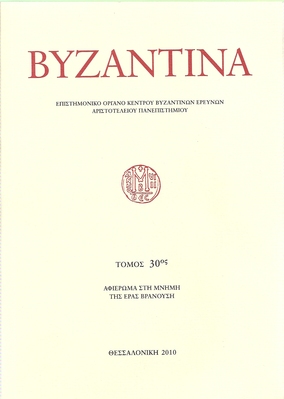Άρτα. Οι βυζαντινές τοιχογραφίες της μονής Κάτω Παναγιάς
Part of : Βυζαντινά : επιστημονικόν όργανον Κέντρου Βυζαντινών Ερευνών Φιλοσοφικής Σχολής Αριστοτελείου Πανεπιστημίου ; Vol.27, No.1, 2007, pages 369-396
Issue:
Pages:
369-396
Parallel Title:
Arta. The byzantine wall paintings of the monastery of Kato Panagia
Author:
Abstract:
The monastery of Kato Panagia, a significant monument of the area of Arta, was built in the middle of 13th c. by the ruler Michael II Comnenos Doucas. Typologically, the catholicon belongs to the type of three-aisles cross-domed basilica, with a cross vault. Its construction is attributed to craftsmen from the Southern Greece.The Byzantine wall paintings are preserved partialy, in the lower part of the walls in the central nave. It is a decorative zone -below that one of the 18th c.- with successive square and rectangular shapes. Those shapes enclose geometric motives with lean lines that remind marble veins.At the Diaconikon apse the figure of Christ in the type of “Palaios ton Himeron” is depicted and underneath it three prelates (saints Meletios, Nikitas and Eleftherios) with cross tunics and precious gospels. In the north part of the arch is depicted the scene of twelve-year-old Christ in the temple, who is presented in the centre under a ciborium (baldacchino), surrounded by four bearded men. In the south part of the same arch the rejection of Joakim’s offerings is depicted in two scenes. On the south wall of the Diaconikon there are four prelates (Hierarchs): the saints Hypatios, Ecumenios, Grigorios of Great Armenia and Anthimos. Another couple of saints, Mode- stos and Akepsimas, is depicted on the north wall.The Diaconikon representations are monumental and with numerous figures. They have a distinguished architectural setting (buildings and other constructions) and they express a continuous movement through the gestures and especially through the moving figures of Joakim and Anna (scene of the offerings rejection) that give the impression that they swing. Likewise, the style of the figures is typical of 13th c. as the element of volume is evident, but comnenian remainings are not completely vanished.Despite the fact that the wall paintings have not been restored yet, we could identify two painters who probably belonged to the same artistic group. The quality of the wall paintings indicates dependence from distinguished models that could not be restricted in Arta’s environment. Indeed, the invitation of artists from a great centre can be justified, as the Kato Panagia monastery was a foundation of the ruler Michael II Comnenos Doucas.The Byzantine wall paintings of Kato Panagia enrich our knowledge concerning the art of the Despotate of Epirus in the middle 13th c. At least four monuments in the area of Arta are decorated by wall paintings of the same period: the church of Saint Basilios “of the bridge” (first phase), the catholikon of the ruined monastery of Pantanassa, the catholikon of Vlacher- na and the church of Saint Theodora in Arta.To conclude, the religious painting in the middle 13th c. in the area of Arta was characterized by a variety of the iconographie program and rich expressive means, due to the different artisan teams that had worked -probably simultaneously- in the same area. The high quality of their work may confirm their provenance from important imperial centres, but it would be premature to identify them, giving the deficient conservation of the wall paintings.
Subject:
Notes:
Περιέχει 21 εικόνες, Το άρθρο περιέχεται στο αφιέρωμα στη μνήμη της Έλλης Πελεκανίδου




